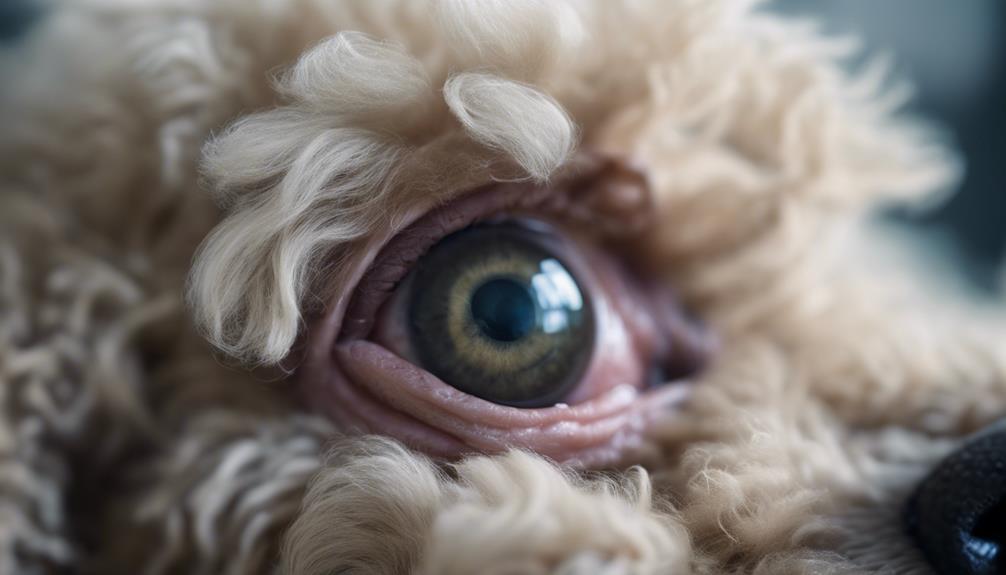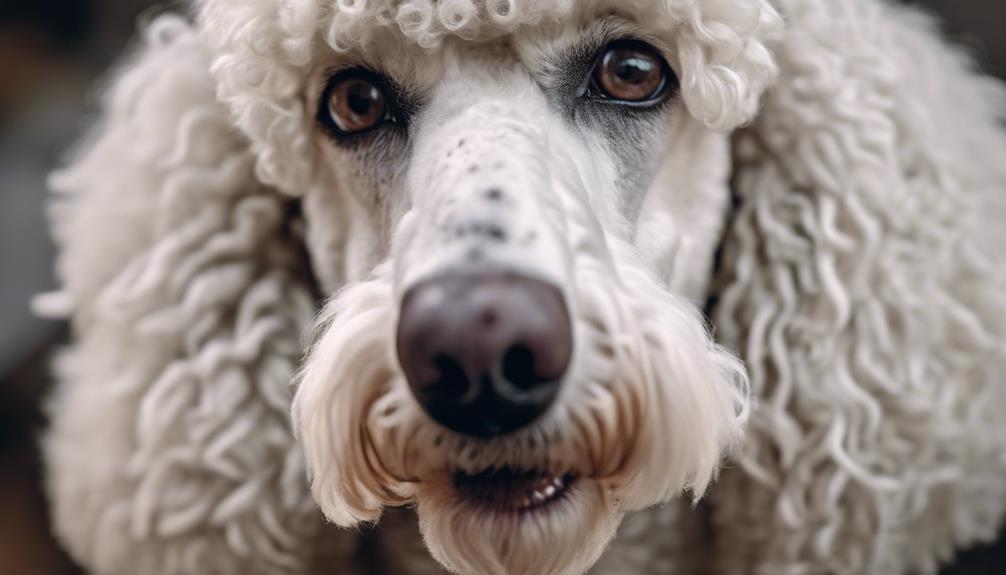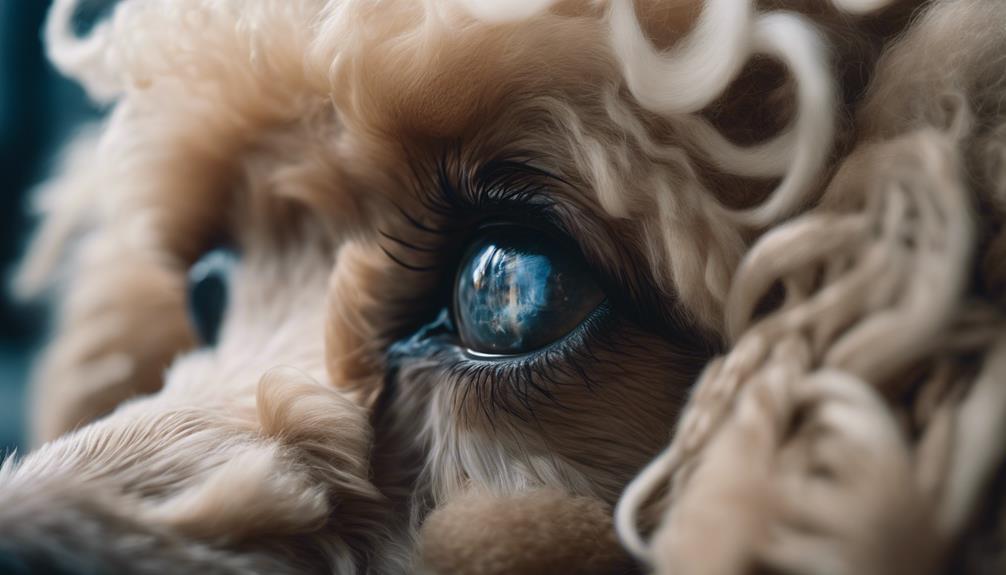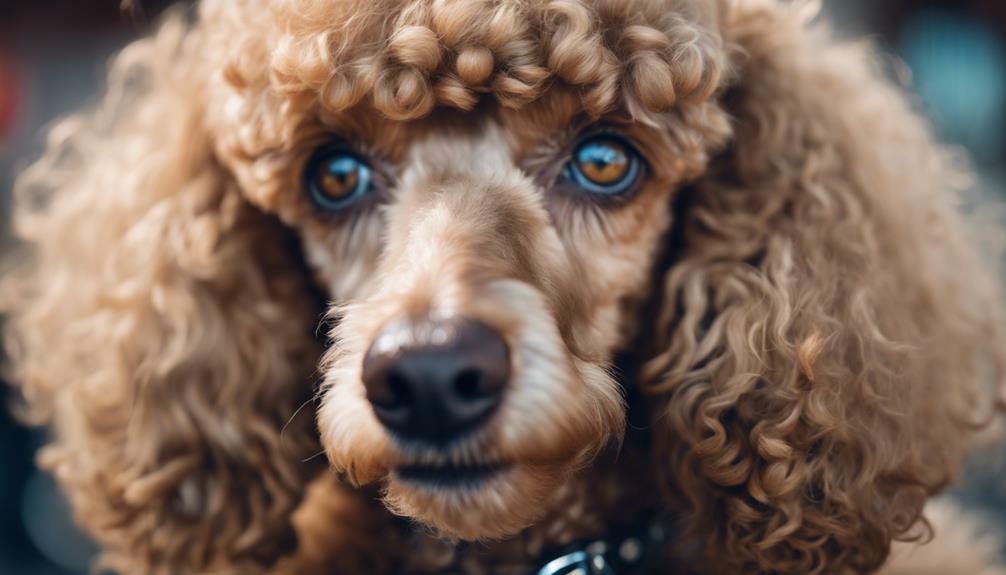When it comes to your poodle's eye health, staying informed is key. From understanding common conditions to implementing proper care, the well-being of your furry companion depends on your knowledge and attention. By recognizing early signs and taking proactive steps, you can ensure a bright future for your poodle's vision. So, let's shed light on the essential aspects of poodle eye health, guiding you through the maze of potential issues and best practices for maintaining those soulful puppy dog eyes.
Key Takeaways
- Early detection of common eye issues like cataracts and tear staining is crucial for proactive care.
- Preventive measures and regular monitoring help maintain optimal eye health in poodles.
- Prompt intervention, including surgery when needed, is vital for managing cataracts effectively.
- Collaborating with veterinarians for specialized care and creating a safe environment supports poodles with eye conditions.
Poodle Eye Health Overview

Why is understanding the Poodle Eye Health Overview crucial for maintaining your poodle's vision and well-being? Poodles, due to their genetic predisposition, are prone to various eye problems. Common poodle eye problems include tear staining, cataracts, and progressive retinal atrophy. By familiarizing yourself with these common conditions, you can actively monitor your poodle's eye health and provide timely care when needed.
Being aware of the signs associated with these issues is vital. Symptoms of poodle eye problems can range from tear stains around the eyes to the development of cloudiness in the lens. By recognizing these signs early on, you can seek veterinary attention promptly, potentially preventing further complications and preserving your poodle's eyesight.
Regular monitoring and attentive care are essential components of maintaining your poodle's eye health. Understanding the common eye issues that poodles face empowers you to be proactive in safeguarding your furry companion's vision and overall well-being.
Common Signs of Eye Issues

When observing your Poodle's eyes, pay attention to signs like excessive tearing leading to tear stains, cloudiness in the eye lens, and difficulty seeing in different light conditions. These may indicate common eye issues such as cataracts or Progressive Retinal Atrophy (PRA). If you notice symptoms like discolored fur, crusty eyes, or vision impairment, it's crucial to seek preventive eye care to address potential problems early on.
Symptoms to Watch
To identify potential eye issues in poodles, closely observe for symptoms such as excessive tearing leading to discolored fur under the eyes and cloudiness in the eye lens. Keep an eye out for these key signs:
- Excessive Tearing: Look for persistent tearing that causes staining under the eyes.
- Cloudiness in the Eye Lens: Watch for a hazy or opaque appearance in the eye, which may indicate a problem.
- Progressive Retinal Atrophy (PRA): Keep track of any changes in your poodle's vision, especially in different lighting conditions.
- Optic Nerve Hypoplasia: Note any difficulties your poodle may have in seeing clearly, especially at night.
Monitoring these symptoms diligently can aid in the early detection and management of potential eye issues in your beloved poodle.
Preventive Eye Care
For proactive poodle eye health maintenance, vigilantly monitor for common signs of eye issues such as excessive tearing, cloudiness in the eyes, and changes in pupil size. Keep an eye out for any red or brown stains under the eyes, which may indicate tear duct problems or infections. Additionally, observe your poodle's behavior for signs like bumping into objects or avoiding bright light, which could signal vision issues. Watch for squinting, eye rubbing, or alterations in eye color or structure. If you notice any concerning symptoms, consult a veterinarian promptly to prevent potential eye problems from escalating. By staying attentive to these signs and seeking timely care, you can help safeguard your poodle's eye health and overall well-being.
Understanding Tear Staining

When dealing with tear staining in poodles, it's crucial to understand the causes, prevention tips, and treatment options available. Identifying the root cause of tear stains, implementing preventive measures, and knowing how to treat existing stains are key aspects to consider. By addressing these points effectively, you can help maintain your poodle's eye health and overall well-being.
Causes of Tear Stains
Tear staining in poodles occurs due to the presence of porphyrin pigment in their tears, which causes discoloration of the fur around the eyes. Here are some key points to help you understand the causes of tear stains:
- Porphyrin pigment in tears leads to fur discoloration.
- Continuous wetness from tear staining can increase the risk of red yeast infections in poodles.
- Removing tear stains requires regular cleaning and grooming efforts.
- Excessive tearing in poodles can result in crusty fur and discomfort around the eyes.
Understanding these causes can assist you in taking appropriate steps to manage tear staining in your poodle effectively.
Prevention Tips
To effectively prevent tear staining in poodles, prioritize maintaining a dry eye area, utilizing tear stain removers, and ensuring meticulous eye hygiene practices. Keep the fur around the eyes clean and dry by using specialized tear stain removers to break down the porphyrin pigment. Regularly trimming the hair around the eyes can also help reduce moisture buildup. Maintain overall eye hygiene by gently cleaning the area with vet-recommended solutions and ensuring that your poodle's face is dry throughout the day. By staying proactive in preventing tear staining and addressing any signs promptly, you can help your poodle avoid discomfort and potential eye conditions associated with excessive tearing and red yeast infections.
Treatment Options
Treatment of tear staining in poodles involves targeted grooming techniques and specialized products to address the underlying causes of fur discoloration. Here are some effective treatment options to help manage tear staining in poodles:
- Regular Grooming: Use gentle grooming techniques to clean the area around the eyes and remove tear stains.
- Specialized Tear Stain Removers: Choose products specifically designed to break down porphyrin pigments and prevent further staining.
- Veterinary Consultation: In severe cases or if tear staining persists, consult a veterinarian to rule out underlying eye conditions like canine cataracts.
- Dietary Adjustments: Opt for high-quality foods that promote eye health and reduce tear production, helping to minimize tear staining.
Managing Cataracts in Poodles

When managing cataracts in poodles, prompt diagnosis and intervention play a critical role in ensuring the best possible outcomes for your pet's eye health. Cataracts in dogs cause cloudiness in the eye lens, resulting in impaired vision that can progress over time. It is essential to recognize the symptoms of cataracts, which can vary depending on the level of opacity in the lens. Early detection is key, as it allows for timely treatment to effectively manage the condition. In many cases, surgery is the most efficient option for addressing cataracts in poodles. This procedure aims to remove the cloudy lens and replace it with an artificial one, restoring clearer vision. Serious attention and prompt intervention are crucial when dealing with cataracts in poodles to prevent further vision deterioration and ensure the best possible quality of life for your furry companion.
Dealing With PRA Symptoms

Progressively managing the symptoms of Progressive Retinal Atrophy (PRA) in poodles requires diligent observation and tailored care strategies to uphold their visual well-being. When dealing with PRA symptoms, consider the following:
- Regular Eye Examinations: Schedule frequent visits to the veterinarian for comprehensive eye exams to monitor the progression of PRA and adjust care routines accordingly.
- Optimal Nutrition: Provide a balanced diet rich in essential nutrients like Omega-3 fatty acids, which may help slow down the degenerative process associated with PRA.
- Environmental Adaptations: Make adjustments at home to create a safe and familiar environment for your poodle, such as minimizing obstacles and using consistent placement of food and water bowls.
- Supplemental Support: Consult with your veterinarian about potential supplements or medications that could support your poodle's eye health and overall well-being while managing PRA symptoms effectively.
Optic Nerve Health in Poodles

Enhancing the optic nerve health of Poodles involves understanding the impact of genetic defects like Optic Nerve Hypoplasia on their vision. Optic Nerve Hypoplasia is a condition that affects the development of the optic nerve in Poodles, leading to varying degrees of vision impairment. To address this issue, it is crucial for Poodle owners to be aware of the symptoms associated with Optic Nerve Hypoplasia, which may include difficulties in visual acuity and navigating their surroundings.
Diagnosis of Optic Nerve Hypoplasia is typically conducted through a comprehensive ophthalmic examination by a qualified veterinarian. Once diagnosed, treatment options will vary depending on the severity of the condition. Regular monitoring and proactive management of Optic Nerve Hypoplasia in Poodles are essential for preserving their eye health and overall quality of life. By staying informed and working closely with veterinary professionals, Poodle owners can help mitigate the impact of this genetic defect and ensure the best possible outcomes for their furry companions.
Frequently Asked Questions
What Eye Problems Do Poodles Have?
Poodles commonly experience tear stains and corneal ulcers. Cataracts and conjunctivitis are prevalent. Glaucoma and dry eye can also occur. Regular eye checks are crucial for poodle owners to detect and address these common eye issues.
What Is the Most Common Disease in Poodles?
Cataracts in Poodles are the most common eye disease. Symptoms like cloudy cornea and impaired vision signal trouble. Preventing poodle blindness requires early diagnosis and prompt treatment. Keep an eye out for glaucoma symptoms too.
What Is the Most Common Eye Disease in Dogs?
When dogs develop eye issues, the most common ailment is cataracts. These cloudy lenses can cloud your furry friend's vision. Early detection and prompt care, like surgery or drops, are vital for managing this condition effectively.
What Is Retinal Degeneration in Poodles?
Retinal degeneration in poodles is a progressive condition causing vision loss due to genetic inheritance. This leads to eventual blindness. Early detection is crucial for managing this issue. Regular vet check-ups can help monitor your poodle's eye health effectively.
Conclusion
In conclusion, it is crucial for poodle owners to stay vigilant about their pet's eye health. Regular monitoring, proper care, and prompt intervention can help prevent and manage common eye conditions such as tear staining, cataracts, PRA, and Optic Nerve Hypoplasia. For example, a poodle named Bella was diagnosed with early-stage cataracts, but with timely treatment and follow-up care, her vision was preserved, highlighting the importance of proactive eye health management in poodles.
